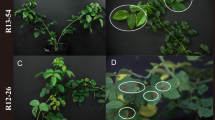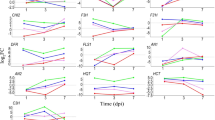Abstract
Most rose cultivars are susceptible to black spot disease caused by Marssonina rosae. To elucidate the effect of leaf structure, callose deposition and H2O2 metabolism on black spot disease resistance, we measured the wax content and cuticle thicknesses of leaves, the callose, H2O2 accumulation, and the SOD, POD, APX and CAT activity and their related gene expression levels in six Rosa species and cultivars infected with M. rosae. The correlation between black spot disease resistance and leaf structure, callose, and H2O2 accumulation, and the role of H2O2 in response to black spot disease were analyzed. The results showed that black spot disease resistance was closely related to H2O2 accumulation, and there was a strong significant negative correlation between disease resistance and H2O2 accumulation (P < 0.01). APX, CAT and POD activity and their related gene expression levels, which are related to H2O2 accumulation, were higher in resistant accessions than in susceptible accessions in the early stage of the plant–pathogen interaction. An increase in H2O2 appeared and antioxidant enzymatic activities increased at the late stage of infection with M. rosae in susceptible accessions, which was different from the trend in resistant accessions. Our results demonstrate that an early and rapid response to H2O2 accumulation in black spot disease-resistant rose accessions could be one of the reasons for resistance against M. rosae. Therefore, regulation of ROS during the early response could be a feasible approach for achieving black spot disease resistance in roses.





Similar content being viewed by others
Data Availability
All the data in the study has been included in the tables and figures in this manuscript.
References
Angel TM, Jones JDG, Dangl JL (2006) Reactive oxygen species signaling in response to pathogens. Plant Physiol 141:2. https://doi.org/10.1104/pp.106.079467
Baker C, Orlandi E (1995) Active oxygen in plant pathogenesis. Ann Rev Phytopathol 33:299–321. https://doi.org/10.1146/annurev.py.33.090195.001503
Biber A, Kaufmann H, Linde M, Spiller M, Ayana DT, Debener T (2009) Molecular markers from a BAC contig spanning the Rdr1 locus: a tool for marker-assisted selection in roses. Theor Appl Genet 120:765–773. https://doi.org/10.1007/s00122-009-1197-9
Byrne D (2015) Advances in rose breeding and genetics in North America. Acta Hort 1064:89–98. https://doi.org/10.17660/ActaHortic.2015.1064.11
Chen XY, Kim JY (2009) Callose synthesis in higher plants. Plant Signal Behav 4:489–492. https://doi.org/10.4161/psb.4.6.8359
Chris L, Richard A (1997) The oxidative burst in plant disease resistance. Annu Rev Plant Physiol Plant Mol BIol. https://doi.org/10.2741/s14
Day B, Graham T (2007) The plant host pathogen interface: cell wall and membrane dynamics of pathogen-induced responses. Ann N Y Acad Sci 1113:123–134. https://doi.org/10.1196/annals.1391.029
Debener T, Byrne D (2014) Disease resistance breeding in rose: current status and potential of biotechnological tools. Plant Sci 228:107–117. https://doi.org/10.1016/j.plantsci.2014.04.005
Delledonne M, Xia Y, Dixon RA, Lamb C (1998) Nitric oxide functions as a signal in plant disease resistance. Nature 394(6693):585–588. https://doi.org/10.1093/jxb/erm244
Ding XL, Xie LY, Lin QY, Wu ZJ, Xie LH (2008) Callose deposition in resistant and susceptible rice varieties under stress of Rice stripe virus. Chin J Plant Protect 80:19–22
Dong JG, Liu XF, Li ZP (2000) Metabolism of reactive oxygen species in maize leaf cells under HT-toxin stress and its possible effects. Plant Physiol Biochem. https://doi.org/10.3969/j.issn.1000-1573.2000.04.016
Gachomo E, Kotchoni S (2010) Microscopic and biochemical evidence of differentially virulent field isolates of Diplocarpon rosae causing black spot disease of roses. Plant Physiol Biochem 48:167–175. https://doi.org/10.1016/j.plaphy.2010.01.003
Gachomo EW, Dehne HW, Steiner U (2007) Studies of the life cycle of Diplocarpon rosae Wolf. on roses and the effectiveness of fungicides on pathogenesis. Inaug Dissert 1–147
Hattendorf A, Debener T (2007) Molecular characterization of NBS-LRR-RGAs in the rose genome. Physiol Plant 129:775–786. https://doi.org/10.1111/j.1399-3054.2007.00876.x
Houot V, Etienne P, Petitot AS, Barbier S, Blein JP, Suty L (2001) Hydrogen peroxide induces programmed cell death features in cultured tobacco BY-2 cells, in a dose-dependent manner. J Exp Bot 52(361):1721–1730. https://doi.org/10.1093/jxb/52.361.1721
Isaacson T, Kosma D, Matas Arroyo A, Buda G, He Y, Yu B et al (2009) Cutindeficiency in the tomato fruit cuticle consistently affects resistance to microbial infection and biomechanical properties, but not transpiration water loss. Plant J 60:363–377. https://doi.org/10.1111/j.1365-313X.2009.03969.x
Jin YF, Huang JX, Chen Y, Kang LM, Che DD (2013) Study on the relationship between some physiological indexes and resistance to black spot of rose. Guangdong Agric Sci 40(10):83–85. https://doi.org/10.16768/j.issn.1004-874x.2013.10.027
Juszczak I, Baier M (2014) Quantification of superoxide and hydrogen peroxide in leaves. Methods Molec Biol 1166:217–224
Kang LG, Qi FK, Xu XY, Li JF (2010) The relationship between the wax and cuticle of tomato leaves and infection of Sesame speckles. China Veg 18:47–50
Kangasjärvi S, Neukermans J, Li S, Aro E, Noctor G (2012) Photosynthesis, photorespiration, and light signalling in defence responses. J Exp Bot 63:1619–1636. https://doi.org/10.1093/jxb/err402
Kaufmann H, Mattiesch L, Lörz H, Debener T (2003) Construction of a BAC library of Rosa rugosa Thunb. and assembly of a contig spanning Rdr1 a gene that confers resistance to black spot. Mol Genet Genom 268:666–674. https://doi.org/10.1007/s00438-002-0784-0
Khosravi P, Kermani M, Nematzadeh G, Bihamta M, Yokoya K (2008) Role of mitotic inhibitors and genotype on chromosome doubling of Rosa. Euphytica 160:267–275. https://doi.org/10.1007/s10681-007-9571-7
Lan HY, Chen ZH (1999) Morphological changes of plant-pathogen fungi interaction and their physiological and biochemical mechanisms and gene regulation. Chin J Bot 04:345–351. https://doi.org/10.3969/j.issn.1674-3466.1999.04.004
Lan SC, Jiang S (2013) Changes of plant cell wall under pathogen stress. Guizhou Science 31(03):17-24+29. https://doi.org/10.3969/j.issn.1003-6563.2013.03.004
Li GJ (2017) Proteomics reveals the role of exogenous NO during response of ‘Zhonghuashoutao’ peach fruit to Monilinia fructicola. Shandong Agricultural University, Shandong
Li L, Ma J, Xiang J, Chen X (2011) Composition difference of epicuticular and intracellular wax layers and the relationship between cuticle and plant stress tolerance. Plant Physiol 47(07):680–684. https://doi.org/10.13592/j.cnki.ppj.2011.07.011
Liang YL, Zhao J, Liu L, Yang J, Li CY (2016) The role of the plant cell wall in plant pathogen interactions. Mol Plant Breed 14(05):1255–1261. https://doi.org/10.13271/j.mpb.014.001255
Liu J, Liu JF, Zeng Y (2001) Morphological and structural resistance of host plants. J Sichuan for Sci Technol 03:54–56. https://doi.org/10.16779/j.cnki.1003-5508.2001.03.016
Liu RF, Jia GX (2020) Expression patterns of key genes of salicylic acid and jasmonic acid/ethylene signaling pathways in the interaction between Rosa and Diplocarpon rosea. Scientia Silvae Sinicae 56(06):47–58. https://doi.org/10.11707/j.1001-7488.20200605
Liu RF, Liu Q, Zhang FY, Yuan XN, Jia GX (2015) The analysis of differential expression genes for Rosa early responding to black-spot disease. Acta Hortic Sin 42(04):731–740. https://doi.org/10.16420/j.issn.0513-353x.2014-0894
Liu YF, Wang WW et al (2019) Research progress on the effects of catalase on plant stress tolerance. Barley Grains Sci 36(01):5–8. https://doi.org/10.14069/j.cnki.32-1769/s.2019.01.002
Llorens E, Carlos A-B, González-Hernández AI, Troncho P, Vicedo B, Yuste T et al (2016) Bioassimilable sulphur provides effective control of Oidium neolycopersici in tomato, enhancing the plant immune system. Pest Manag Sci 73:1017–1023. https://doi.org/10.1002/ps.4419
Ma Q, Cui HW, Wei GR, Dong ZY (1995) Studies on histology and ultrastructure of resistance to Pseudoperonospora cubensis in cucumber. J Northwest Agric Univ 05:33–38
Malek B, Debener T (1998) Genetic analysis of resistance to black spot (Diplocarpon rosae) in tetraploid roses. Theor Appl Genet 96:228–231. https://doi.org/10.1007/s001220050731
Meng ZQ (2007) Study on enzyme activity of Rosa hybrida resistant to black spot. J Anhui Agric Sci 24:7454–7455. https://doi.org/10.13989/j.cnki.0517-6611.2007.24.077
Peng M, Kuc J (1992) Peroxidase-generated hydrogen Peroxide as a source of antifungal activity in vitro and on tobacco leaf disks. Phytopathology 82:696–699. https://doi.org/10.1094/Phyto-82-696
Raymond O, Gouzy J, Just J, Badouin H, Verdenaud M, Lemainque A et al (2018) The Rosa genome provides new insights into the domestication of modern roses. Nat Genet 50:772–777. https://doi.org/10.1038/s41588-018-0110-3
Reddy S, Spencer JA, Newman SE (1992) Leaflet surfaces of black spot-resistant and susceptible roses and their reactions to fungal invasion. HortScience 27:133–135. https://doi.org/10.21273/HORTSCI.27.2.133
Russin JS, Guo BZ, Tubajika KM et al (1997) Comparison of kernel wax from corn genotypes resistant or susceptible to Aspergillus flavus. Phytopathology 87(5):529–533. https://doi.org/10.1094/PHYTO.1997.87.5.529
Saini S, Kaur N, Pati P (2018) Reactive oxygen species dynamics in roots of salt sensitive and salt tolerant cultivars of rice. Anal Biochem 550:99–108. https://doi.org/10.1016/j.ab.2018.04.019
Sharma A, Vats S, Pati P (2014) Post-infectional dynamics of leaf spot disease in Withania somnifera. Ann Appl Biol 165:429–440. https://doi.org/10.1111/aab.12148
Shen J, Wu Y, Jiang Z, Xu Y, Tangchun Z, Wang J et al (2019) Selection and validation of appropriate reference genes for gene expression studies in Forsythia. Physiol Mol Biol Plants 26:173–188. https://doi.org/10.1007/s12298-019-00731-y
Sherwood RT, Vance C (1980) Resistance to fungal penetration in Gramineae. Phytopathology 70:273–279. https://doi.org/10.1094/phyto-70-273
Spiller M, Linde M, Oyant L, Tsai C-J, Byrne D, Smulders MJM et al (2010) Towards a unified genetic map for diploid roses. Theor Appl Genet 122:489–500. https://doi.org/10.1007/s00122-010-1463-x
Tian LB, Shang S, Yang Y, Si LT, Li DD (2013) Relationship between leaf structure and resistance to powdery mildew in Momordica charantia. Acta Bot Boreali Occident Sin 33(10):2010–2015
Wang CF (2008) Studies on Histological and cytochemical of oxidative burst during wheat-Puccinia striiformis f. tritici interaction. Northwest A&F University, Shaanxi
Whitaker V, Bradeen J, Debener T, Biber A, Hokanson S (2009) Rdr3, a novel locus conferring black spot disease resistance in tetraploid rose: genetic analysis, LRR profiling, and SCAR marker development. Theor Appl Genet 120:573–585. https://doi.org/10.1007/s00122-009-1177-0
Whitaker V, Debener T, Roberts A, Hokanson S (2010) A standard set of host differentials and unified nomenclature for an international collection of Diplocarpon rosae races. Plant Pathol 4:745–752. https://doi.org/10.17660/ActaHortic.2015.1064.11
Xu TL (2020) Defense mechanism of rose against the infection of Marssonina rosae. Beijing Forestry University, Beijing
Xu T, Wu Y, Yi X, Tan J, Zhao H, Yu C et al (2018) Reinforcement of resistance of modern rose to black spot disease via hybridization with Rosa rugosa. Euphytica. https://doi.org/10.3321/j.issn:0577-7518.2008.01.004
Yang SM, Pei WY, Xu TL et al (2019) Resistance evaluation of black spot disease in Rosa germplasm resources. In: Zhang QX (ed) Advances in ornamental horticulture of China. China Forestry Publishing House, Beijing, pp 288–296
Zhao J, Wang Y, Chai CB, Song YQ, Li LL (2017) Relationship between early structural characteristics of pear leaves and occurrence of scab. J Shanxi Agric Univ (nat Sci Edn) 37(08):575–579. https://doi.org/10.13842/j.cnki.issn1671-8151.2017.08.008
Zhou ZM, Shen RX, He ZG, Lei ZP (1979) Study on the resistance of Populus tomentosa to rust caused by Melampsora magnusiana. J Beijing for College 10:61–66
Acknowledgements
This work was supported by the Beijing Natural Science Foundation Project (6192018), the World-Class Discipline Construction and Characteristic Development Guidance Funds for Beijing Forestry University (Grant No. 2019XKJS0323).
Author information
Authors and Affiliations
Contributions
Huitang Pan designed the experiments. Shumin Yang, Tingliang Xu, Yi Yang and Wenyue Pei carried out the experiments, Huitang Pan, Shumin Yang, Le Luo, Chao Yu, Jia Wang, Tangren Cheng and Qixiang Zhang wrote the manuscript. All authors read and approved the final manuscript.
Corresponding author
Ethics declarations
Conflict of interest
The authors declare that they have no competing interests.
Additional information
Communicated by Inhwa Yeam.
Publisher's Note
Springer Nature remains neutral with regard to jurisdictional claims in published maps and institutional affiliations.
Supplementary Information
Below is the link to the electronic supplementary material.
Rights and permissions
Springer Nature or its licensor holds exclusive rights to this article under a publishing agreement with the author(s) or other rightsholder(s); author self-archiving of the accepted manuscript version of this article is solely governed by the terms of such publishing agreement and applicable law.
About this article
Cite this article
Yang, S., Xu, T., Yang, Y. et al. H2O2 accumulation plays critical role in black spot disease resistance in roses. Hortic. Environ. Biotechnol. 64, 1–14 (2023). https://doi.org/10.1007/s13580-022-00458-y
Received:
Revised:
Accepted:
Published:
Issue Date:
DOI: https://doi.org/10.1007/s13580-022-00458-y




